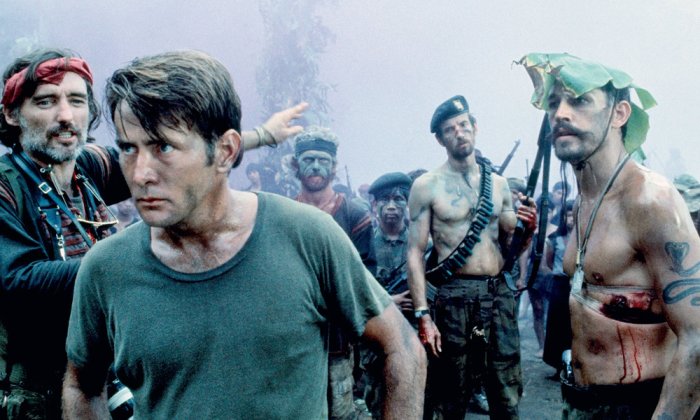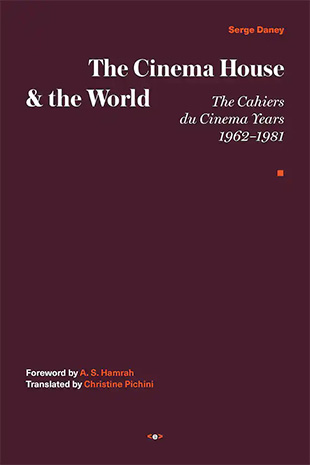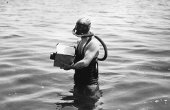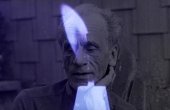Legendary Film Critic Serge Daney on Coppola’s ‘Apocalypse Now’

Jean Luc-Godard once professed that Serge Daney was the end of criticism as he understood it. One of the greatest film critics of his generation, Daney, who died in 1992, wrote for the French film magazine Cahiers du Cinéma before becoming a journalist for the daily newspaper Libération. He wrote, recalls Patrice Rollet in the preface to a sweeping new volume of Daney’s translated writings, “between the here (excursions to Parisian theaters) and elsewhere (‘world cinema’ festivals), between upstream (cinema that had ‘watched his childhood’) and downstream (films that he followed, out of loyalty, ‘to television’).” He wrote, continues Rollet, “from one shore to another of the cinematic river (as in a work by Renoir or Ford), and in the wake of the films that he followed down or up, dreamily or frantically (as in a work by Laughton or Coppola).” Always, as evidenced in the 1979 essay that follows, Daney’s criticism is open and challenging, polyvocal, and compulsively readable.
—The Editors
When it comes to an extraordinary film such as Apocalypse Now, the wisest thing is to begin with what struck everyone who saw it, namely its disappointing side, the failure, even, of its final section. All of us, when confronted with this kind of film, become spectators “in the first degree” and even rather good critics: we are astonished by it or we are not. I would just like to point out here that the film is the story not of one, but of two, three, or even four ascents upriver and that if, as Blanchot says, “the Apocalypse disappoints,” it’s because it is in its nature to disappoint. To all that river carries, there is no possible ending.
First ascent. From Concrete to Abstract: War
The history of cinema goes hand in glove with the history of war. The French army was one of the first operators of the Lumière brothers’ invention. Once it became global, waged by everyone against everyone, war drove all of modern European cinema, from Rome, Open City to The Carabineers. Bazin has written about the delight taken in the “spectacle of urban destruction” that he called the “Nero complex,” for which he considered cinema to be the privileged site. In America, cinematographic techniques and the technology of war were of a pair: killing and filming “progressed” in tandem. The film viewer gradually became accustomed to being a survivor.

This is the viewer whom Coppola is pursuing today, the one who escaped massacres — or who returned from them — as he presents the most modern of wars, the one whose image has not yet faded away. From the Vietnam War, Coppola keeps only what makes it a new kind of war (but a newness that integrates the old: trenches, javelins) and erases everything that might refer to a certain timelessness of war. None of those scenes then, so frequent in Hawks, Walsh or Fuller, in which soldiers talk — about war, for example. None of those soldiers’ speeches about the horrors of war in general (as in Walsh’s The Naked and the Dead, which records the debate over antimilitarism) or the legitimacy of a particular war. Useless, then, to look for a position on America’s engagement in Vietnam in Apocalypse Now.
Just like The Deer Hunter, the film participates in the business of political amnesia, except that with Cimino, it’s from the point of view of a reactive withdrawal and with Coppola, the historical dimension is short-circuited at the outset by a direct passage from the physical to the metaphysical, through a screenplay inspired by Conrad. And at the same time, Apocalypse Now bears witness to the Vietnam War, insofar as it is not the simple repetition of Korea or the Pacific, by showing — for the first time with this kind of intensity — what technologically makes it an other war. When, in The Naked and the Dead, a field burns, it creates a beautiful image for the audience; in Apocalypse Now, when Willard and his men meet up with a battalion preparing to napalm a field, it is primarily a spectacle for the characters in the film. No pauses, then, no downtime, but a constant acceleration, changes in speed, ellipses at the very heart of the scenes.
The history of cinema goes hand in glove with the history of war.
Sound — a particularly manipulative use of the Dolby effect — plays a prominent role, not by anchoring the image, making it more intelligible, but on the contrary, by tearing it open from the inside, by keeping it from becoming a refuge for the audience, by inspiring fear. In other words, no more offscreen. The effect is completely breathtaking. The sequence most often cited as the best in the film (correctly, in my opinion, and I will return to it) in this respect is the helicopter battle. Why? Quite simply because, like Fabrice at Waterloo, we understand that we have never really seen a helicopter. We find ourselves below signification: a helicopter is a helicopter, nothing more; an explosion an explosion, a death a death. Too quickly, we meet objects that mean nothing to anyone, but that kill. War is primarily that concrete, too concrete place.
I suppose that if Coppola had ended the film before the Kurtz chapter, he would have exposed himself to widespread outrage, and the film’s distributors (who, in this case, are often producers) would have refused to show it in theaters. Conversely, film critics (us, for example) would have found the film admirable because it was formally appropriate for the unintelligibility of war, a war seen from below, without “ascent.” And yet, the double bind that Coppola has not been able to escape is this: the audience (and millions are needed to make the film profitable) come at first for the war scenes, but they find accepting this “at first” difficult: they need an ending, a dénouement, of intelligibility that will retrospectively justify those scenes. Ultimate meaning as cover for the jouissance of non-meaning. As for Coppola, he wanted this final section, even though we know that it was a struggle for him to decide exactly what it would be. There is a moment when, after going upriver, we pass from the concreteness of war (things in the flash of their being-there, in their mortal irruption) to abstraction (things that begin to signify, sometimes heavily, to support something beyond themselves). Here is where the film runs aground. As if it were impossible (or else, he needed more time) to lead the audience from its stupor towards another relationship to the film in which it would be invited to begin to “think for itself” again. Thinking is either shocked or stimulated, meaning it is either retained or disseminated. Coppola has not really made a choice. Plus, while he is an extraordinary engineer, while he films military operations with real skill, with actual machines and actual bodies, as soon as the image becomes oversignified and the story metaphorical he is much less at ease. Of course, this play between suspension and the dissemination of meaning is the gamble of really big movies, monster-films (for films that stupefy, expand interpretations, that don’t conclude: see Tati, Fellini and especially Kubrick, who is magnified when compared to Coppola). The paradox is this: these films can now only be made in places — the USA, perhaps the USSR, empires in any case — where it is forbidden not to draw a conclusion, not to edify.
Second ascent. From Father to Son: the Godfather
But the river carries something else. It carries, for example, what every narrative is based on: the ascent towards the essence of filiation, of sons towards fathers, of Oedipus towards Laius. Curiously, John Milius’s screenplay reminds us of a very small film, a masterpiece, generally disregarded overseas: Nicholas Ray’s Wind Across the Everglades. There too, a character is removed from civilization and reigns over a group of outlaws and wrecks at the heart of a kingdom that’s both splendid and nauseating: the Florida Everglades. There too, a young man is progressively caught up in the horror of what goes on in that realm, horror that he is fully aware concerns him. With Ray, an ecologist ahead of his time, birds are massacred; with Coppola, it is more serious. A turbid friendship binds two men: the older intimidates the younger but will finally be killed by him. After the murder, the younger suspects he will never be the same.
If we discover anything at the end of the ascent upriver, it’s that the father was not really killed: he had wanted to die all along and waited impatiently for his murderer.
“Horror!” Willard says in the final scenes of the current version of Apocalypse Now before getting back into his boat. He has discovered the horror of filiation, the passage through mimetic violence (he begins to resemble Kurtz), etc. But that passage is rigged. The real subject — with Coppola, as with Ray, as indeed with Welles in Mr. Arkadin — is uncovering of the homosexual bond, insofar as it is fundamental to all society, to all “fraternity,” hence to all war. But this bond is not so easily severed. There is indeed an Oedipal situation, but it is seen from the perspective of the myth’s great forgotten one, Laius. A Laius who would have disguised his suicide as a murder to strip Oedipus of the fact of it. If we discover anything at the end of the ascent upriver, it’s that the father was not really killed: he had wanted to die all along and waited impatiently for his murderer. Horror, then, but not the one we had thought. Of course, in Coppola’s film, this entire section is somewhat theoretical, because we don’t actually believe in the identification between Willard and Kurtz. It was much stronger in Wind Across the Everglades, with Burl Ives and Christopher Plummer, even though they are more limited than Sheen and Brando as actors, because Nicholas Ray was a great filmmaker. The false father, the “rigged father” of Apocalypse Now is Brando, someone who enforces a protectorate rather than a law, a “godfather” rather than something else; in any case, a living myth. For upstream of Apocalypse Now’s river is also old Hollywood. Coppola belongs to a generation of filmmakers who are doing their work while their ancestors are still living, and who know it. A generation that began in France with the New Wave, when Godard literally inscribed Fritz Lang’s name and body (in Contempt), and who have recently arrived in America (see Truffaut in Spielberg’s film). There too, we could say that Brando’s killing is an infinite operation — by virtue of the very particular position Brando holds in the American industry: he is a little like the Kurtz of that industry — infinitely disappointing, as well.
Third ascent. The One and the Other: America
Yes, Apocalypse Now is an exceptional film. It is also an average American film of the post-Vietnam era. American cinema lately has centered around the theme of the presence of the Other within ourselves. Other in the sense of “alien,” the title of America’s biggest hit of the summer. “Us” is, of course, once more, the American who abusively considers himself to be the universal equivalent of the human species. Except that “being” American is never very obvious or very simple (I won’t dwell on the melting-pot and other myths), and it seems like one is always ready to do just about anything to be even more American (anything: see Kazan).
Coppola ascends the river of civilization to barbarism, not the barbarism of others, but the one that we originated from, that all of civilization originated from.
Ideologically, the concern of all of these films (Alien, The Exorcist, The Deer Hunter, even Close Encounters of the Third Kind) is to make Americans even more American by having them exorcise an Other (evil, in general) that haunts or inhabits them. The novelty of these films, their power, too, is that they decided to no longer skimp on the means (technology, again) to demonstrate the other, the alien, within ourselves. Previously, it was mostly B movies that attacked this theme (in the fifties, around anti-communism), but with meager resources, limited to weak special effects or writerly manipulations (the Tourneurian off-screen) that only shocked viewers who were very naïve or very sophisticated (cinephiles). The decision to show the unshowable is fairly recent. There are different versions. With Cimino, the Asian is responsible for waking the monster that was sleeping in us: he is killed while being shamed for having awakened the monster: a familiar story. With Ridley Scott (Alien), the protean monster literally surges up from the human body and occupies the spaceship like a cancer whose unpredictable metastases are petrifying. With Friedkin or Kubrick, we have more coded, literary themes, of the devil or the double. As for Apocalypse Now, it has what is probably, at the level of the screenplay, the greatest literary dignity (Conrad). There, one and the other, Willard and Kurtz, are of the same species, the same race, the same country, the same training (the Army). And yet, one of them has become a monster. A monster with whom he must identify. Coppola ascends the river of civilization to barbarism, not the barbarism of others, but the one that we originated from, that all of civilization originated from, on the side of the paternal horde. If that ascent is also cut short, it is because Coppola didn’t really choose between surrealist insanity and ethnographic cruelty. The “people of the abyss” who adore Kurtz are not credible enough for this final section’s apogee, the parallel slaughter of Kurtz and the animal sacrifice, to generate the sacred horror that we find in Pasolini (in Pigsty: “I killed my father, I feasted on human flesh and I tremble with joy…”).
Fourth ascent: The Show and the Showman: Coppola
Coppola may not be as profound a filmmaker as Kubrick (to stay with the heavyweights). His treasure hunt leads nowhere, really; it disappoints us. And yet, he is an extraordinary entrepreneur of spectacles, and Apocalypse Now’s greatest success is that other ascent upriver that leads Willard to Kurtz from spectacle to spectacle, almost from “show to show.” That is where Coppola is often a very great filmmaker. What he retains from the war, from that war, is that for those who waged it (on the American side) it became a spectacle without a director. Nothing can come out of this war that is no longer discussed, no longer understood, except show business tableaux vivants. Willard — embodied completely by Martin Sheen — is the spectator par excellence: everything that he meets is either experienced, or deliberately staged, as if it were a performance. This ranges from the quick shot of Coppola filming himself as a television journalist to the final phantasmagoria, products of Kurtz’s delirium, with the young Black soldier on the boat singing “Satisfaction” in between. It is true of Dennis Hopper, entangled by cameras and photographic equipment, who is like Kurtz’s first assistant, his court jester and griot. It is obviously true of the extraordinary scene of the performance staged for the soldiers (for a moment, I sensed that Coppola had touched upon the essence of war: on a floating dance floor and in a cloud of pink smoke, the nocturnal exhibition of a handful of women for a horde of young men, as if in a dream). It is true of the truly apocalyptic scene in which everyone mistakes Willard for the officer in charge. But it is especially true of the extraordinary episode of the helicopter battle and the character played by Robert Duvall. If this is the best scene of the film, it is because it creates the right mix of the “real” (the being-there of things) and the “spectacle” (being desired by someone). Duvall is not the deus ex machina, the demiurge, that Willard seeks; he is a bricoleur. He can only bombard a village on a whim or make soldiers surf. He is like an anticipation of Kurtz (except that he seems far more convincing to me), Kurtz who, at the end of the river and at the heart of chaos, is the last director who still has actors to direct, a kingdom to decorate and an audience who will listen to him read the poems of T.S. Eliot. But Coppola is clearly, like Duvall’s character, an entrepreneur of spectacles rather than a visionary — like Kurtz.
And so, “the apocalypse disappoints us.” In Lacanian terms, we could reproach Coppola for having attempted the impossible: to film the unrepresentable phallus. Even Brando’s bald head doesn’t suffice. But it is as much out of calculation as out of naiveté that he had to make the film this way. For while he succeeded in shooting the film exactly as he wanted to, despite innumerable impediments, he was simultaneously forced to make a film of an almost standard length, with a real ending, etc., out of what was an enormous amount of filmed material. Perhaps he lacked the power to assume a lavish economy to the very end, to earn the right not to conclude.
(Cahiers du Cinéma #304, October 1979)
Serge Daney became the editor of Cahiers du Cinema in 1974. In 1981, he left Cahiers and wrote about visual culture for Libération, turning his attention to television and coverage of the Gulf War. Daney died of AIDS-related causes in 1992. This article is excerpted from “The Cinema House and the World: The Cahiers du Cinema Years, 1962–1981,” published by Semiotext(e).



